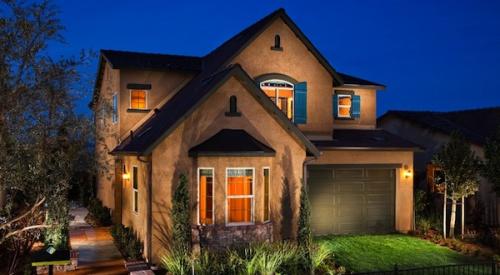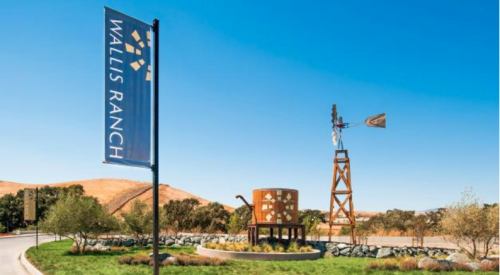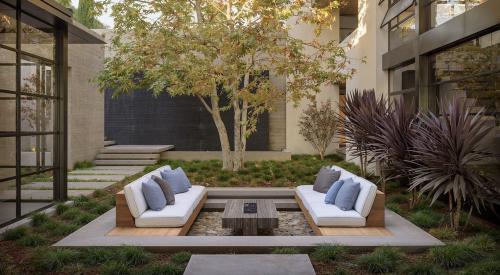|
The Estates at the Preserve's 25 estate homes are tucked into the natural topography of Hampden Township in Cumberland County, Penn. — high living in the shadow of coal-mining country.
The model offers creature comforts amid luxury features, including a studio space that includes both a washer/dryer and plasma TV. It's a workroom that allows for play, so it's never dull. Among the other perks: a first-floor owner's retreat, a basement spa and a home theater.
 The Henley model at the Estates at the Preserve incorporates classic revival style with flexible spaces; natural light; and a high regard for proportion and scale. |
"Hampden Township is one of a few desirable townships on the west shore of Harrisburg," says Robert Bowman, president of Central Pennsylvania's Charter Homes and Neighborhoods, the developer of the Estates at the Preserve. It's located near the Susquehanna River in the highly sought-after Cumberland Valley School District. Restaurants, parks and other amenities lie nearby.
"We completed several other neighborhoods in Hampden Township and decided that the [topography] of the property as well as the location — its easy access to Interstate 81 — made for a unique opportunity to build what we believe is the premier neighborhood for this area," says Bowman. "The larger home sites, the open space and the floor plans we introduced were a step up from what we had done before."
The Estates at the Preserve sit on 87 acres, 27 of which have been preserved as open space with walking trails, including an on-site creek and stream.
"The property includes black outcropping," says Bowman. "It has a historic building on it, and it sits right on the side of what's known as Blue Mountain, which is the first significant ridge line that runs through the capital region to the northwest. You have this tremendous view looking up the hill," Bowman adds. "We thought it would be a neat opportunity to take advantage of building homes here."
The Henley has been the most popular floor plan at the Estates, in both Phase I and Phase II, the current phase.
Doug Phillips, design director for Charter Homes, says there are four design principles the company strives to incorporate into every home plan: flexible spaces, natural light, site lines and timelessness, "which we like to define as architecture that has the correct proportions and scale and has an architectural integrity about its language."
"With the Henley, what we looked at was a classic revival-style," says Phillips. "We tried to look at proportions and scale and come up with a design that is very time-tested. And we always try to come up with a couple of features that are unique in the marketplace in general."
Intriguing Spaces   The breakfast nook and kitchen open to a great room with lots of natural light from plentiful windows. |
"There are lots of windows, which goes to our design principle of natural light, as well as our site lines," says Phillips. "You'll notice when you come in the foyer, you can look the whole way through into the great room. The great room has lots of glass out to the rear. That enables you to look through the house.
"I remember looking at the owner's retreat and carving it up in ways so you just don't have one view to look at," he adds. You look to your right and you see something that's beyond that. It's intriguing and it makes you want to know what's behind that wall. That's what makes spaces interesting."
The studio is a unique feature available in the Henley plan.
"It would have normally been a very large laundry room," says Phillips, "but instead we looked at it as a space that could be used for laundry, sewing or doing crafts with the kids. We ended up taking this larger space that measured somewhere around 11½ by 16 feet and put in counter space for homework. We have a central island for crafts with plenty of storage space."
"It includes the laundry appliances and a sink," says Bowman. "But we were smart enough to include a 42-inch big screen TV as well. So while you're in there doing laundry or crafts or holiday presents, you don't feel like you're in some part of the house that's far removed from the activity.
"The studio connects into the main hallway into the house, and then through the garage," adds Bowman. "That provides an opportunity for home-owners to dump whatever they have coming into the home, fix anything they need to fix, store light bulbs, etc. People used to have a junk drawer; this is kind of like a junk room."
ChallengesCharter cultivated a neighborhood feel in the shadow of the mountains.
"The property had a lot of natural features," says Bowman, "so we allowed those to organize where to put the home sites and the streets. The homes are grouped together to create not just one large mass of housing. There are groups of homes within the neighborhood that connect with each other.
 The Estates at the Preserve has 27 acres of open space; the Henley is the most popular plan. |
"Because the edges of the property are more heavily wooded, we have and are continuing to make a significant investment in the landscaping," Bowman adds. "Everything from the front entry to the street trees, the planning of the open space — all things we are either doing or enhancing in some way with landscaping. We do that in most of our neighborhoods, but in this case it demanded a lot of thought in terms of how we could bring the existing landscape into the neighborhood."
OutcomeA total of 36 homes have sold to date for both phases of the development, for a total of $20 million. Four of the homes sold were Henleys.
"We have one of the highest price points in the Harrisburg region," says Bowman. "It speaks to both the location and the quality of the product."
"We try to make our architecture what I refer to as not a one-trick pony," says Phillips. "Everyday when you wake up ... here in the Henley, you say, 'Wow, I'm so glad I got this,' because you never tire of it. There's something that you discover each day about it that you like."
|












